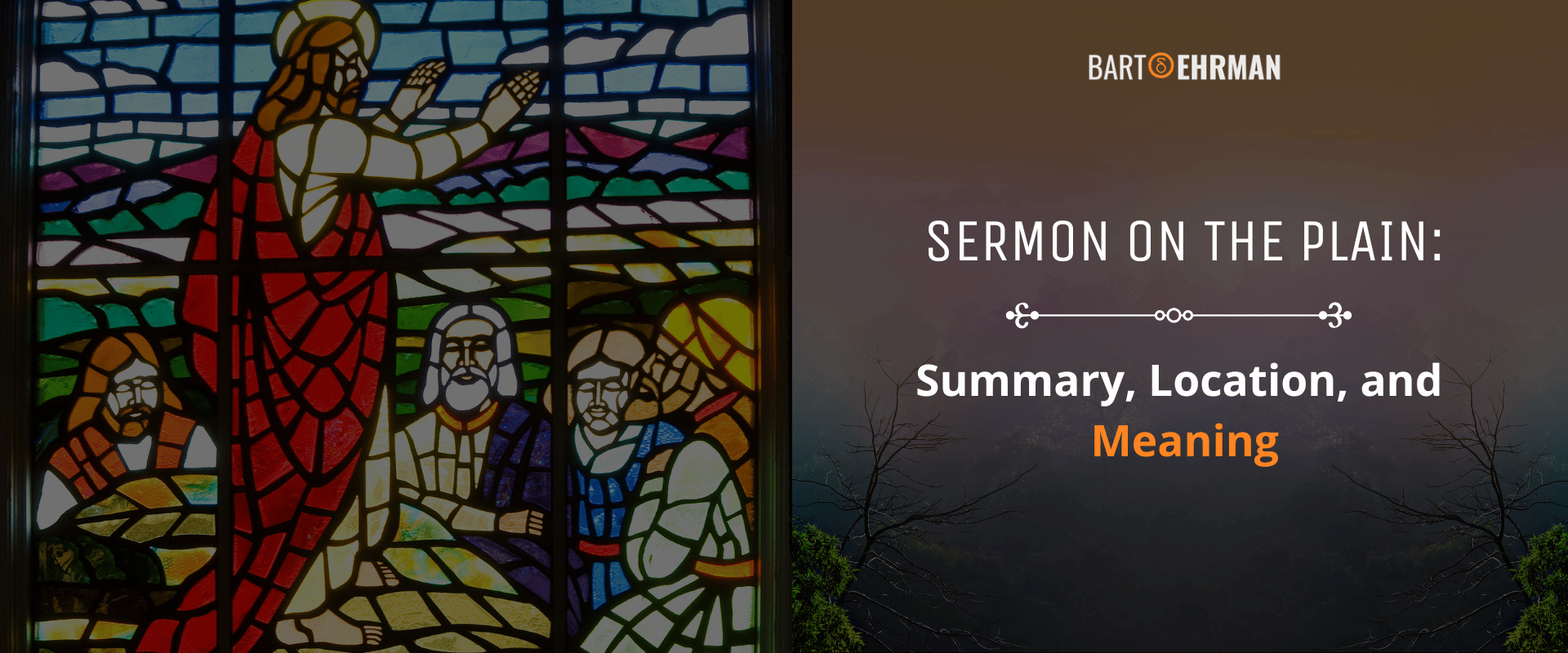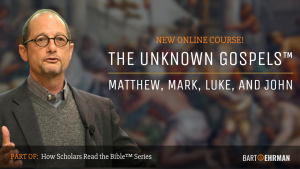Sermon on the Plain: Summary, Location, and Meaning

Written by Joshua Schachterle, Ph.D
Author | Professor | Scholar
Author | Professor | BE Contributor
Verified! See our editorial guidelines
Verified! See our guidelines
Edited by Laura Robinson, Ph.D.
Date written: September 22nd, 2024
Disclaimer: The views and opinions expressed in this article belong to the author and do not necessarily match my own. - Dr. Bart D. Ehrman
The Sermon on the Plain in Luke is a compelling yet often overshadowed counterpart to the more celebrated Sermon on the Mount found in the Gospel of Matthew. It is a succinct compilation of Jesus' moral and ethical directives, addressing themes of justice, compassion, and righteousness.
In this article, I’ll examine the Sermon on the Plain, including its content, its historical context, and the meanings behind what it teaches. By comparing its teachings with those of the Sermon on the Mount, I’ll show how Luke's portrayal of Jesus' sermon reflects his unique concerns and priorities.

The Sermon on the Plain in Luke
The Sermon on the Plain is a title later ascribed to this group of teachings because in Luke 6:17 it says that Jesus “came down with them and stood on a level place” to speak to crowds. This contrasts with the Sermon on the Mount in Matthew 5,6, and 7, which says Jesus “went up the mountain” to address the crowd. We’ll look later at some additional comparisons between the two sermons. For now, let’s examine a brief summary of the sermon’s contents which I’ll eventually explain more fully.
The Sermon on the Plain is entirely contained within Luke 6. It begins with the Beatitudes (“Blessed are…”) from Luke 6:20-26. In 6:27-36, Jesus speaks of loving one’s enemies and turning the other cheek. The Golden Rule is articulated in verse 31. Next, Jesus tells his audience not to judge others to avoid being judged themselves and to forgive others to be forgiven themselves in 6:37-38. The “blind leading the blind” parable, along with a note that a “disciple is not above the teacher, but every disciple who is fully qualified will be like the teacher,” is found in 6:39-40a.
The metaphor of removing a log or beam from one’s own eye before attempting to remove a splinter from another’s eye is found in 40b-42. Verses 43-45 contain the metaphorical saying about good trees producing good fruit and bad trees producing bad fruit. In verse 46, Jesus asks “Why do you call me ‘Lord, Lord’ and do not do what I tell you?,” implying that obedience to Jesus constitutes reverence. Finally, in verses 47-49, Jesus tells the parable of the man who builds his house on rock, thereby surviving a storm, versus the man who builds his house on sand, which allows the house to be washed away. Those who follow his teachings, says Jesus, are like the first man.
History and Explanation of the Sermon on the Plain
There are several logical and historical reasons to assume that the Sermon on the Plain never happened the way it’s described in Luke. Instead, the author of Luke likely compiled several of Jesus’ teachings into one chapter (actually only part of a chapter). Let’s look at why most scholars believe this.
To illustrate the difficulty of reporting Jesus’ sermons accurately from memory, Bart Ehrman, noting that Luke was written more than 50 years after the death of Jesus, asks readers to accomplish a task. Noting that President Lyndon Johnson gave his televised State of the Union speech in 1965, he asks that anyone who heard it to simply write it down. The impossibility of such a task mirrors the implausibility of anyone, even an eyewitness, writing down an entire sermon they had heard more than 50 years ago.
Additionally, Ehrman notes that, while Jesus’ Sermon on the Plain is much shorter than the Sermon on the Mount (only about a quarter of the length) and contains much of the same material, Luke’s Gospel places many of the teachings from the Sermon on the Mount in different settings in the Gospel. Luke 11, for instance, has the Lord’s Prayer, while Luke 12 includes the teaching about not worrying and trusting God. If this were originally all part of one sermon, why would Luke have split up the teachings?
For these and other reasons, Sharon Ringe, in her commentary on Luke, agrees with most scholars that what we now call the Sermon on the Plain is “more like a collection of somewhat related teachings on a variety of themes, rather than a coherent argument or a single ‘sermon’ delivered at one time.” Jesus probably did deliver sermons and speak to crowds, but no human being could possibly remember such a speech with perfect clarity decades later.
FREE COURSE!
WHY I AM NOT A CHRISTIAN
Raw, honest, and enlightening. Bart's story of why he deconverted from the Christian faith.
Over 6,000 enrolled!
Themes in the Sermon on the Plain
Both the Sermon on the Mount and the Sermon on the Plain come from source material that scholars have long called the Q source (for the German word for source: Quelle). In short, Q is a theoretical text which contains all the material shared by Matthew and Luke that they don’t share with Mark, their principal source. It should be noted, by the way, that not all scholars accept the existence of the Q source (see Mark Goodacre’s The Case Against Q: Studies in Markan Priority and the Synoptic Problem) and a physical copy has never been found.
Either way, much of the material from both Matthew and Luke’s sermons is the same or very similar. However, there are differences between the two which highlight variations in the authors’ emphases. In this section, I’ll explore the Sermon on the Plain, underscoring where it diverges from the Sermon on the Mount and what those differences illustrate about the author of Luke.
Beatitudes (verses 20-26)
Luke, like Matthew, begins with beatitudes:
Blessed are you who are poor,
for yours is the kingdom of God.
Blessed are you who are hungry now,
for you will be filled.
Here we find instructive comparisons with Matthew’s beatitudes. Luke begins with “Blessed are the poor,” while Matthew’s version says “Blessed are the poor in spirit.” Then Luke says “Blessed are you who are hungry now,” whereas Matthew says “Blessed are those who hunger and thirst for righteousness.” What do these differences tell us about what matters to these Gospels’ respective authors?
For Matthew, in the Sermon on the Mount, Jesus was speaking of spiritual and/or ethical matters. “Poor in spirit” means “humble,” and “hunger and thirst for righteousness” denotes wanting to follow God’s ethical precepts. This makes perfect sense since for Matthew, Jesus is a new lawgiver, a new Moses, if you will.
Luke, though, is talking about literal poverty and hunger. This makes equal sense since Luke is very concerned with God’s care for the poor. Look, for example, at these lines from the Magnificat, Mary’s song of praise to God in Luke 1:46-55:
He has brought down the powerful from their thrones
and lifted up the lowly;
he has filled the hungry with good things
and sent the rich away empty.
You can find lines like these, emphasizing God’s love of the poor and condemnation of the rich throughout the Gospel of Luke. For this reason, while Matthew begins with nine beatitudes, Luke starts with just four, following them with negative pronouncements for the wealthy in verses 24-25:
But woe to you who are rich,
for you have received your consolation.
Woe to you who are full now,
for you will be hungry.
Love for Enemies (verses 27-36)
In his commentary on Matthew 1-7, Swiss theologian Ulrich Luz wrote that the notion of loving one’s enemies, found in both Matthew and Luke, was an innovation that separated Christianity from all other religions. However, in The Gospel of Matthew: a Commentary on the Greek Text, John Nolland disagrees, finding ample evidence of this idea in texts predating the New Testament.
For instance, Proverbs 25:21 says
If your enemies are hungry, give them bread to eat,
and if they are thirsty, give them water to drink.
Similarly, Nolland points to a Babylonian text called Counsels of Wisdom, written in the 2nd millennium BCE, which says "Do not return evil to the man who disputes with you; requite with kindness your evil-doer... smile on your adversary." Finally, Nolland points out that another work from the 2nd millennium BCE, the Egyptian Instruction of Amenemope says the following:
Row that we may ferry the evil man away,
For we will not act according to his evil nature;
Lift him up, give him your hand,
And leave him [in] the hands of god;
Fill his gut with your own food
That he may be sated and ashamed.
In short, loving one’s enemies was not an idea invented by Jesus or Christians in general, admirable though it may be. The injunction to “turn the other cheek” if one is hit, goes along with loving one’s enemies: if you can’t do good to someone who hurts you, at least don’t harm them.
By the way, there is a notable difference between the ending of this section in Matthew and in Luke. In Matthew 5:48, Jesus tells his audience to “Be perfect (Greek: teleios), therefore, as your heavenly Father is perfect.” Perfect here is defined as treating both friends and enemies well. Luke 6:36, on the other hand, has Jesus tell his listeners “Be merciful (Greek: oiktirmones), just as your Father is merciful.” In both cases, the point is treating everyone kindly, but Luke’s emphasis on caring for the poor conceives of this as mercy rather than perfection.
The Golden Rule (verse 31)
Like the notion of loving enemies, the idea of treating others the way you want to be treated, found equally in Matthew and Luke, originated before Jesus. The phrase “Love your neighbor as yourself” from Leviticus 19:8, for instance, is clearly an inspiration for Jesus, who says that it is one of the greatest commandments. Jewish sage Hillel the Elder, who lived before Jesus, said this was the most important verse of the Torah.
Similar ideas are found in ancient Greece, ancient India, and ancient Egypt. In short, this was a common moral injunction in the ancient world.

Not Judging (verses 37-42)
In Luke 6:41, Jesus asks “Why do you see the speck in your neighbor’s eye but do not notice the log in your own eye?” The metaphor suggests that those who attempt to control others’ behavior are often oblivious to their own faults and hypocrisy. This is also the point of the “blind leading the blind” analogy: if you don’t see your own faults, how can you guide the behavior of another?
Jesus, therefore, says here that those who judge others will be judged themselves, while those who forgive others will themselves be forgiven.
The Tree and Its Fruits (verses 43-45)
In verses 43-45, Jesus says that a good tree produces good fruit, while a bad tree produces bad fruit. In this case, the “tree” is the heart of the person:
The good person out of the good treasure of the heart produces good, and the evil person out of evil treasure produces evil, for it is out of the abundance of the heart that the mouth speaks.
While Matthew and Luke share this analogy, again, their different emphases produce different meanings from the text. In Matthew, the metaphor refers specifically to testing prophets to see whether they are true or false. Luke, on the other hand, merely says that the speech and behavior of any person will demonstrate whether that person’s heart is good or evil.
“Why Do You Call Me Lord, Lord?” (verse 46)
Here, Jesus asks why someone would call him “Lord” but not follow his commandments. In his Social-Science Commentary on the Synoptic Gospels, Bruce Malina, noting that the term “Lord” (Greek: kyrios) was not just a religious term, but a form of address to anyone of higher status, says that to call someone “Lord” was also to acknowledge that person as your patron or protector. He goes on to say that a client who did not do what the patron asked risked losing that person’s protection. This is what Jesus invokes here.
The Wise and Foolish Builders (verses 47-49)
Finally, Jesus tells a parable about one man who built his house on a foundation of rock and, thus, survived a storm, while another built on a foundation of sand and was swept away.
This story is a continuation of the above section in which those who hear and do what Jesus says build upon the “rock” of his commandments. Those who hear and don’t do what he says build their lives on a less-than secure foundation. Sharon Ringe points out that the point of the story is that “what is needed to ground a person in Jesus’ teachings is to move from learning as an intellectual or emotional achievement to learning embodied in action.”
Conclusion
The Sermon on the Plain is the Sermon on the Mount’s lesser-known cousin. Compressed into part of only one chapter in Luke 6, it is much shorter than Matthew’s sermon and omits several of the Sermon on the Mount’s teachings, only to bring them out later in different contexts. Many scholars believe the source of these teachings is the theoretical Q source.
Most scholars don’t believe that either the Sermon on the Mount or the Sermon on the Plain are merely transcriptions of an actual sermon Jesus gave. Instead, they are collections of Jesus’ most important teachings, at least according to the individuals and/or communities that produced these Gospels.
While the Sermon on the Mount paints Jesus as a new Moses or lawgiver, the Sermon on the Plain makes him into a prophetic figure who, like the prophets of the Hebrew Bible, is concerned with justice for the poor. Accordingly, phrases that appear more spiritual and/or ethical in Matthew — “Blessed are the poor in spirit” or “those who hunger and thirst for righteousness” — become more tangible — “Blessed are you who are poor” and “you who hunger” — in Luke.
Not only does Luke’s Jesus pronounce blessings on those who are poor, but he also condemns those who are rich, implying that God is on the side of the poor, one of the main themes in Luke.

